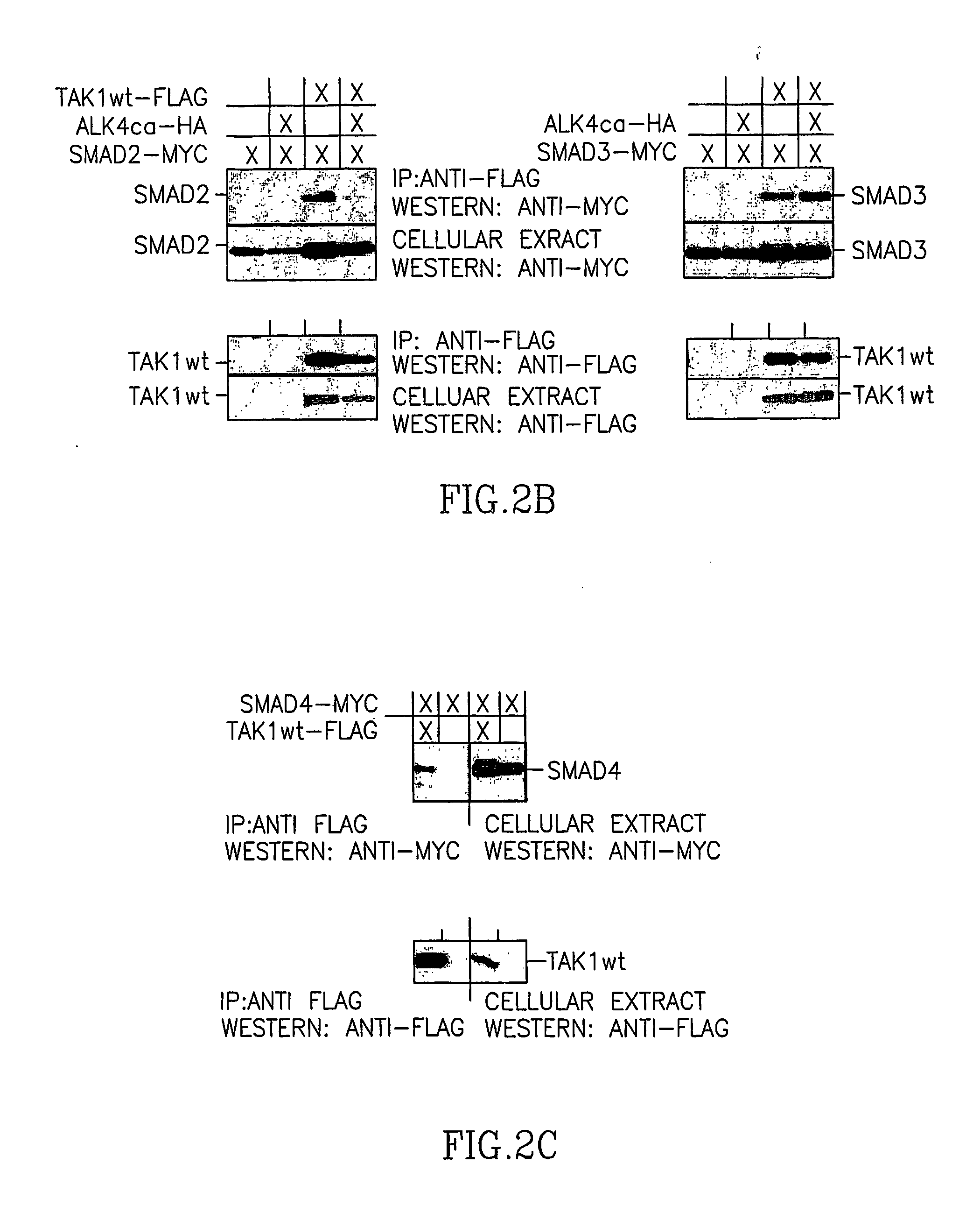Tak1-mediated inhibition of osteogenesis
a technology of osteogenesis and tak1, which is applied in the direction of transferases, drug compositions, genetic material ingredients, etc., can solve problems such as undefined, and achieve the effects of enhancing osteogenesis, enhancing osteogenesis, and enhancing bone repair
- Summary
- Abstract
- Description
- Claims
- Application Information
AI Technical Summary
Benefits of technology
Problems solved by technology
Method used
Image
Examples
example 1
Biologically Active TAK1 Splice Variants
[0183] To determine whether TAK1 expression and biological activity were comparable in tissue and in C3H10T½ cells, full-length TAK1 cDNA was generated by PCR from total murine kidney RNA and in the mesenchymal progenitor cell line C3H10T½. The isolated TAK1 cDNA exhibited a high degree of homology to human TAK1b, which has since been confirmed (Genbank accession number XM—131329; FIG. 1A), and is a longer transcript form than one previously described (Yamaguchi K et al, 1995, ibid). Among nine tissues examined, both TAK1 long and short forms were expressed in every tissue assessed apart from kidney (FIG. 1B). TAK1 tissue-specific expression levels varied, with minimal lung expression detected. Both TAK1 splice variants were comparably expressed in the mesenchymal progenitor line, C3H10T½(see FIG. 8A). TAK1 mutants generated from the long transcript form included dominant-negative (TAK1dn) and constitutively active (TAK1ca) variants as compar...
example 2
TAK1 Preferential Interaction with Latent SMADs
[0184] Since TAK1 is activated by ligands of the TGF-β and BMP family, and SMADs are involved in signaling cascades of the latter, it was important to determine whether direct SMAD interaction with TAK1 in cells can be demonstrated. Toward this end, co-immunoprecipitations with various combinations of wild-type TAK1 (TAK1wt) and R-SMADs, either in a latent form or post-activation by constitutively active BMP type I receptor (ALK6ca, BMPR-IB) or activin type I receptor ALK4ca (ActR-IB), I-SMADs and SMAD4, were conducted. TAK1 was found to co-immunoprecipitate, hence interact with, all R-SMADs tested (FIG. 2). TAK1 interaction with R-SMADs was typically stronger in the absence of constitutively active receptors (the exception being SMAD3), which may reflect a reduced affinity for activated, i.e. phosphorylated R-SMADs by TAK1, except with SMAD3. Other members of the SMAD family of proteins also exhibited a significant affinity for TAK1. ...
example 3
SMAD MH2 Domains Mediate TAK1 Binding
[0187] SMAD deletion mutants were prepared in order to determine which domains were necessary and sufficient for TAK1 binding. Since all SMADs were found to bind TAK1 (FIG. 1 c) and the MH2 domain is the only structural motif common to all it seemed the likeliest candidate for TAK1 binding. Indeed, for both SMAD1 and SMAD3 the MH2 domain sufficed to mediate TAK1 interaction, with MH1 and linker domains not involved in the TAK1 interaction (FIG. 3a, b).
[0188] The MH2 C-terminal sequences of R- , Co- and I-SMADs demonstrated the greatest degree of homology among SMADs, with the exception of a few terminal amino acids. The terminal amino acids are subjected to receptor-mediated phosphorylation in R-SMADs and thus differ from co-SMAD4, and are absent in I-SMADs.
[0189] MH2 C-terminal sequences do not mediate TAK1 binding, despite their highly conserved nature. SMAD7 deletion mutants (1-389) lacking 38 C-terminal conserved amino acids common to all ...
PUM
| Property | Measurement | Unit |
|---|---|---|
| pH | aaaaa | aaaaa |
| length | aaaaa | aaaaa |
| nucleic acid sequence | aaaaa | aaaaa |
Abstract
Description
Claims
Application Information
 Login to View More
Login to View More - R&D
- Intellectual Property
- Life Sciences
- Materials
- Tech Scout
- Unparalleled Data Quality
- Higher Quality Content
- 60% Fewer Hallucinations
Browse by: Latest US Patents, China's latest patents, Technical Efficacy Thesaurus, Application Domain, Technology Topic, Popular Technical Reports.
© 2025 PatSnap. All rights reserved.Legal|Privacy policy|Modern Slavery Act Transparency Statement|Sitemap|About US| Contact US: help@patsnap.com



